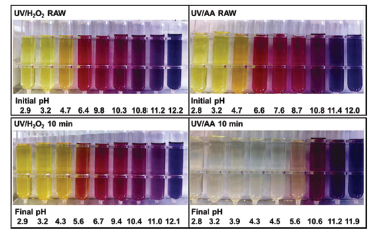| [1] Ren, N. Q.; Zhou, X. J.; Guo, W. Q.; Yang, S. S. Chin. J. Chem. Eng. 2013, 64, 84. (任南琪, 周显娇, 郭婉茜, 杨珊珊, 化工学报, 2013, 64, 84.)[2] Tanaka, K.; Padermpole, K.; Hisanaga, T. Water Res. 2000, 34, 327.[3] Yoo, E.; Libra, J.; Adrian, L. J. Environ. Eng. 2001, 127, 844.[4] Lei, P. X.; Chen, C. C.; Ma, W. H.; Zhao, J. C. Acta Chim. Sinica 2005, 63, 1551. (雷鹏翔, 陈春城, 马万红, 赵进才, 化学学报, 2005, 63, 1551.)[5] Chen, C. C.; Ma, W. H.; Zhao, J. C. Chem. Soc. Rev. 2010, 39, 4206.[6] Marin, M. L.; Santos-Juanes, L.; Arques, A.; Amat, A. M.; Miranda, M. A. Chem. Rev. 2012, 112, 1710.[7] Konstantinou, I. K.; Albanis, T. A. Appl. Catal. B 2004, 49, 1.[8] Baxendale, J.; Wilson, J. Trans. Faraday Soc. 1957, 53, 344.[9] Wang, M. S.; Liu, X. T.; Pan, B. C.; Zhang, S. J. Chemosphere 2013, 93, 2877.[10] Tan, Y. M.; Xu, R. F.; Hu, W. K.; Zhang, P. Chin. J. Process Eng. 2004, 4, 234. (谭益民, 徐瑞芬, 胡伟康, 张鹏, 过程工程学报, 2004, 4, 234.)[11] Tu, D. H.; Li, P.; Shi, C. H. Techniques and Equipment for Environmental Pollution Control 2004, 5, 30. (涂代惠, 李萍, 史长林, 环境污染治理技术与设备, 2004, 5, 30.)[12] Zhang, S. J.; Liu, X. T.; Wang, M. S.; Wu, B. D.; Pan, B. C.; Yang, H.; Yu, H. Q. Environ. Sci. Technol. Lett. 2014, 1, 167.[13] Liu, X. T.; Song, X. J.; Zhang, S. J.; Wang, M. S.; Pan, B. C. Phys. Chem. Chem. Phys. 2014, 16, 7571.[14] Lei, L. C.; Wang, D. H. Advanced Oxidation Processes for Water Treatment, Chemical Industry Press, Beijing, 2001, pp. 198~200. (雷乐成, 汪大翚, 水处理高级氧化技术, 化学工业出版社, 北京, 2001, pp. 198~200.)[15] Stylidi, M. Appl. Catal. B 2004, 47, 189.[16] Mofaddel, N.; Bar, N.; Villemin, D.; Desbène, P. L. Anal. Bioanal. Chem. 2004, 380, 664. Chen, B. Y.; Hsueh, C. C.; Liu, S. Q.; Hung, J. Y.; Qiao, Y.; Yueh, P. L.; Wang, Y. M. Int. J. Hydrogen Energy 2013, 38, 15598. |
